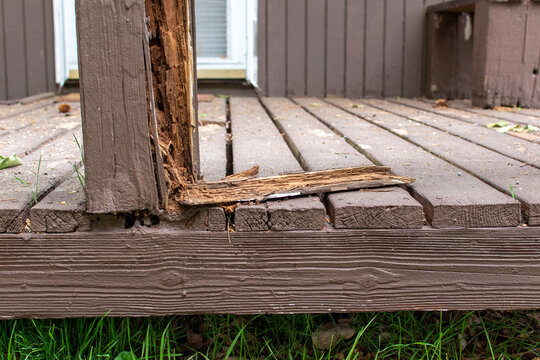A deck can be a beautiful and functional extension of your home, but it’s also exposed to the elements all year long. Over time, even the strongest deck can show signs of wear—and one of the most critical problems to look out for is a rotted deck post. Whether you’re dealing with structural sagging or visible decay, the big question is: Should you repair the post or replace it altogether?
From understanding wood rot to comparing wood vs deck screws, code requirements, material types like composite deck boards, and a full cost breakdown, we’ll cover everything you need to know.
Understanding the Role of Deck Posts
Deck posts are the vertical supports that hold your entire deck above ground. When a post fails, it’s not just an eyesore—it’s a major safety hazard. Damaged posts can lead to sagging, unstable railings, or even a complete collapse of your structure.
What Causes a Deck Post to Rot?
Wood rot happens when moisture, fungi, and oxygen combine. Deck posts—especially older ones made from untreated lumber or lacking a proper deck finish—are vulnerable to rot, especially near the base where water collects.
Common Causes of Wood Rot:
- Constant moisture exposure
- Lack of drainage around the footing
- Inadequate sealing or staining
- Use of the wrong fasteners (wood screws instead of deck screws)
If you’re seeing dark, soft, or crumbling spots near the bottom of your post—or if your deck with railing wobbles when leaned on—rot could be the culprit.
Spot the Damage Early: Signs You Shouldn’t Ignore
Before deciding between repair and replacement, examine the post and surrounding deck framing thoroughly. Here are the warning signs:
- Post movement or wobble
- Visible cracks or splitting
- Soft, spongey wood near the base
- Rusting connectors or brackets
- Loose or unsafe railing (check against railing code requirements)
When Repair Might Be Enough
Repairing is typically possible if:
- The rot is surface-level.
- It’s isolated to one post.
- The surrounding framing and joists are still in good shape.
Common Repair Techniques:
- Epoxy Wood Repair: Fill minor rot spots with epoxy or wood filler.
- Sistering: Attach a new wooden board to the damaged post to reinforce it.
- Base Reinforcement: Add brackets or supports to strengthen the area.
They buy time but may not eliminate the issue long-term.
When Replacement is the Smarter Move
If the rot is deep or has spread into the deck framing, it’s safer—and often cheaper in the long run—to replace the entire post.
You Should Replace If:
- The post is crumbling or completely soft.
- Multiple posts are compromised.
- The post has pulled away from the deck or footing.
Cost Comparison: Repair vs. Replacement
Cost of Repairing a Rotted Post
| Task | DIY Cost Range | Pro Cost Range |
|---|---|---|
| Wood epoxy/filler | $15 – $40 | $100 – $150 |
| Metal brackets/fasteners | $25 – $70 | $75 – $200 |
| Wood board for sistering | $20 – $60 | $150 – $300 |
| Labor (if applicable) | N/A | $200+ |
| Finishing/staining | $20 – $50 | $100+ |
| DIY Estimate | $75–200 | |
| Professional Estimate | $300–500 |
Cost of Replacing a Deck Post
| Task | DIY Cost Range | Pro Cost Range |
|---|---|---|
| Pressure-treated post | $25 – $75 | Included |
| Composite deck board post | $80 – $150 | Included |
| Concrete footing materials | $10 – $30 | Included |
| Hardware + fasteners | $15 – $50 | Included |
| Labor | N/A | $300–600 |
| DIY Estimate | $100–250 | |
| Professional Estimate | $400–900 |
Note: Composite posts cost more upfront but are often rot-resistant and low maintenance, saving money in the long-term.
Wood vs Deck Screws: Which to Use?
One of the simplest ways to prolong your deck’s life is choosing the right fasteners. Deck screws are specifically designed for outdoor use and resist corrosion, while traditional wood screws may rust and loosen over time—leading to instability and more rot.
Always opt for galvanized or stainless steel deck screws when repairing or replacing posts or railings.
Step-by-Step: How to Repair a Rotted Deck Post
- Scrape and Clean: Remove decayed wood with a chisel or screwdriver.
- Dry the Area: Let the wood dry thoroughly before applying filler.
- Apply Wood Hardener: To solidify surrounding soft spots.
- Fill Gaps with Epoxy: Mold it to match the shape of the post.
- Sand and Finish: Use matching deck finish or stain.
- Reinforce if Needed: Sister with a new wood board or add brackets.
Pro Tip: This is only viable if the rot hasn’t reached the core or footing.
Step-by-Step: How to Replace a Rotted Deck Post
- Support the Deck: Use jacks or temporary braces.
- Remove Old Post: Detach the railing, joists, and base fasteners.
- Check the Footing: Pour new concrete or install a post base if needed.
- Install New Post: Use pressure-treated or composite deck board posts.
- Reconnect Beams and Railing: Ensure you follow railing code requirements.
- Seal the Wood: Apply a weathered wood finish or waterproof sealant.
Composite Deck Boards vs Wood: Which Is Better for Posts?
| Feature | Wood | Composite Deck Board |
|---|---|---|
| Cost | Lower upfront | Higher upfront |
| Maintenance | Needs regular sealing | Minimal |
| Rot Resistance | Prone to rot | Highly resistant |
| Lifespan | 10–15 years | 25+ years |
| Appearance | Natural grain | Variety of styles available |
If you’re investing in long-term durability, composite deck board posts are an excellent choice—especially in wet climates.
Deck Code Compliance: Don’t Overlook This
Many homeowners forget that changes to a deck—even just a post—must meet railing code requirements and local building codes.
- Railings must be 36–42 inches tall.
- Balusters must be spaced less than 4 inches apart.
- Posts must be anchored to concrete or pier footings.
- Fasteners must be corrosion-resistant and rated for exterior use.
Hidden Costs of Delaying Repairs
Ignoring a rotted deck post can lead to the following:
- Sagging beams
- Wobbly railings
- Failing deck framing
- Complete structural collapse
Plus, small repairs turn into large expenses when rot spreads. What might have been a $100 fix could quickly become a $2,000 rebuild.
What If the Post Is Attached to a Railing?
Many posts are integrated into the deck with railing systems. If your post is part of the guardrail, safety becomes even more critical.
Real-Life Examples
Minor Repair Success
Location: Minnesota
Problem: Surface-level rot, isolated to one post
Solution: DIY epoxy repair + bracket reinforcement
Cost: $120
Lifespan Added: 5+ years
Replacement Required
Location: South Carolina
Problem: Rot spread to beam and multiple posts
Solution: Full post replacement + upgraded composite board + new railing
Cost: $2,300
Lifespan Added: 20+ years
Final Verdict: Repair or Replace?
| Situation | Recommendation |
|---|---|
| Light surface rot | Repair |
| Post under 10 years old | Repair |
| Deep rot or structural instability | Replace |
| Multiple affected posts | Replace |
| Planning a deck upgrade soon | Replace |
Long-Term Costs & Value Comparison
| Option | Upfront Cost | Lifespan | Total Value |
|---|---|---|---|
| DIY Repair | Low | 2–5 yrs | Short-term fix |
| Wood Replace | Medium | 10–15 yrs | Moderate value |
| Composite Post | High | 25+ yrs | Best value |
Let the Experts Help: Carter’s Painting Services
Deciding between repair and replacement isn’t always simple. If you’re still unsure, Carter’s Painting Services can provide expert advice and trusted craftsmanship.
Why Choose Carter’s?
- Certified team with experience in deck framing and restoration
- Specialists in weathered wood finish, railing systems, and code compliance
- Affordable services using the right deck screws and materials
- Options for wood or composite deck board posts
- Comprehensive solutions—from inspection to finishing touches
Whether you need a quick fix or a total overhaul, Carter’s Painting Services has the tools, expertise, and service to bring your deck back to life—stronger, safer, and better looking than ever.
Visit Carter’s Painting Services today to schedule a free consultation and take the guesswork out of your next deck project.


